Generation K: The Disturbing Rise of Ketamine Abuse Among Young People
In recent years,a new substance has emerged as a contender in the landscape of youth substance abuse: ketamine. Originally developed as an anesthetic and increasingly legitimate in mental health treatment for conditions like depression, ketamine has found its way into the hands of a younger demographic looking for escape or enhancement. Its hallucinogenic effects and dissociative properties have attracted attention, but the ramifications of its growing popularity among adolescents and young adults are alarming. Reports of misuse have surged, raising concerns among parents, educators, and health professionals about the implications for mental health and societal well-being. As we delve into this unsettling phenomenon, we will explore the reasons behind the rising trend of ketamine abuse, the profiles of those affected, and the urgent need for awareness and intervention in combating what some are dubbing “Generation K.”
The Surge of Ketamine Use Among Adolescents
In recent years, an alarming trend has emerged, where ketamine—a substance typically recognized for its anesthetic properties—is increasingly being misused among adolescents.This surge is not merely anecdotal; studies indicate a significant rise in ER visits related to ketamine misuse, prompting public health officials to sound the alarm. Various factors contribute to this troubling pattern, including the ongoing stigma surrounding mental health treatment, the allure of ketamine’s dissociative effects, and the rising prevalence of experimental drug culture among teens. educational institutions are left grappling with understanding how to approach this issue while ensuring that students receive the help they need.
Experts attribute the rise of ketamine abuse to a combination of social media influence and misinformation regarding its effects.The following points elucidate some critical dimensions of this issue:
- Social acceptance: The portrayal of ketamine in online forums and platforms as a party drug has inadvertently glamorized its use.
- Lack of Awareness: Many adolescents, misinformed about the dangers, perceive its use as harmless or as a shortcut to coping with stress.
- Accessibility: The drug’s increasing availability due to illicit markets plays a crucial role in its growing popularity.
| Year | ER Visits (Ketamine-related) |
|---|---|
| 2018 | 1,500 |
| 2019 | 2,800 |
| 2020 | 4,200 |
| 2021 | 6,600 |

understanding the Psychological Factors Behind Substance Abuse
The rise in ketamine abuse among young individuals can be partially attributed to various psychological factors that substantially influence their behavior. Peer pressure often plays a central role, with young people feeling compelled to conform to the behaviors of their social circles. Additionally, an increasing sense of anxiety and depression within this demographic leads many to seek rapid relief through substance use, despite the risks involved. other contributing factors include feelings of isolation, low self-esteem, and an overall declining mental health that make the allure of a temporary escape from reality particularly appealing.
Moreover, the availability and perceived safety of ketamine have also fueled its rise among youth. Unlike other illicit drugs, ketamine is sometimes viewed as less harmful due to its medical usage as an anesthetic and is frequently enough misconceived as a “party drug” that can enhance social experiences. The following table outlines some common psychological factors related to substance abuse among youth, illustrating how multifaceted this issue truly is.
| Psychological Factor | Description |
|---|---|
| Peer Pressure | Influence from friends leading to drug experimentation. |
| Anxiety | Using substances to manage feelings of stress and worry. |
| Depression | Seeking an escape from overwhelming emotional pain. |
| Low Self-Esteem | Turn to substances to feel more confident or accepted. |
| Isolation | Using drugs to cope with feelings of loneliness. |

The Health Risks Associated with Ketamine Misuse
As the misuse of ketamine continues to rise among young people, understanding the potential health risks is crucial.Many users initially perceive the drug as a harmless party substance, yet prolonged use can lead to serious mental and physical complications. Short-term effects include dissociation, hallucinations, and anxiety, which can trigger risky behaviors and poor decision-making. Moreover,frequent use may result in more severe health concerns,such as:
- Bladder damage: Repeated use can cause ketamine-induced ulcerative cystitis,leading to chronic pain and frequent urination.
- Cognitive impairment: Long-term users may experience memory loss, difficulties with concentration, and reduced cognitive abilities.
- Mood disorders: Increased risk of depression and anxiety disorders often follows regular ketamine abuse.
Additionally, the risk of dependence and addiction cannot be overlooked, as individuals may find themselves increasingly reliant on the substance for emotional relief or escapism. The psychotropic effects of ketamine can also amplify pre-existing mental health conditions, creating a dangerous cycle of addiction. The following table outlines some of the long-term effects of ketamine misuse:
| Health Risk | Potential Consequences |
|---|---|
| Bladder Damage | Chronic pain, frequent urination |
| Cognitive Impairment | memory loss, difficulty concentrating |
| Mood Disorders | Increased depression, anxiety |
| Dependency | Addiction, withdrawal symptoms |

Preventative Measures: Educating Young People on the Dangers of Ketamine
To effectively combat the rising trend of ketamine abuse among youth, educational initiatives must be at the forefront.Schools and community organizations can lead the way by developing complete programs that focus on the dangers associated with this substance. These programs should include:
- Interactive Workshops: Engage students in discussions about the risks and effects of ketamine, helping them to understand the potential consequences of use.
- Peer Education: Empower young people to act as peer educators, sharing authentic stories and creating an open dialog about substance abuse.
- Parental Involvement: Equip parents with resources and guidance to talk with their children about the dangers of drugs and build a supportive household environment.
Furthermore, informational campaigns utilizing various media channels can raise awareness on the signs of ketamine abuse and provide resources for those in need. Schools should consider implementing preventative strategies such as:
| Strategy | Description |
|---|---|
| Anonymous Reporting Tools | Allow students to report abuse or reach out for help without fear of repercussions. |
| Awareness Days | Host events focusing on substance abuse awareness to engage the entire school community. |
| Counseling Services | Provide accessible mental health resources for students struggling with substance-related issues. |

Support Systems: How Parents and Communities Can Combat Abuse
In addressing the alarming trend of ketamine abuse among youth, parents and communities play a pivotal role in creating robust support systems. Open lines of interaction between parents and children are essential. By fostering an environment where teenagers feel safe discussing their challenges, concerns, and peer pressures, parents can gain insight into the risks their children may face regarding substance misuse. Key strategies include:
- Active Listening: Ensure that children feel heard without immediate judgment or punishment.
- Regular Check-ins: Create routines where discussing feelings and daily experiences is normal.
- informative Engagement: Educate themselves about the risks associated with drug use, particularly ketamine.
Beyond the family sphere, community involvement can significantly enhance the fight against substance abuse. Schools, local organizations, and healthcare providers must collaborate to create a comprehensive support network. Effective initiatives include:
- Prevention Programs: implementing educational campaigns in schools that address ketamine and other substance abuses.
- Counseling Services: Providing access to counseling for adolescents struggling with substance use or mental health issues.
- Community Events: Hosting workshops and seminars that promote awareness and offer coping strategies for managing stress and peer pressure.
Future Implications: The Long-Term Effects of Ketamine on Youth Mental Health
The potential long-term effects of ketamine use among youth are still murky, but emerging research suggests several concerning implications for mental health. repeated exposure to ketamine could lead to neuroplastic changes, potentially impairing cognitive functions, emotional regulation, and overall psychological resilience. Studies have hinted at a risk of chronic depression or anxiety,as adolescents may develop a reliance on the drug as a coping mechanism,thus exacerbating their mental health issues rather than resolving them. Moreover, the possibility of substance use disorder may arise, where the behavior of seeking out ketamine compromises their social relationships, academic performance, and family dynamics.
As we explore the future landscape of youth mental health in the context of ketamine abuse, we must also consider its societal dimensions. Public health strategies need to evolve to address the escalating trend, emphasizing education and prevention over reaction.Here are some key focus areas for future initiatives:
- Accessible Mental Health Resources: Increasing the availability of counseling and support services.
- Awareness Campaigns: Educating youth about the risks associated with ketamine.
- Parental Guidance: Encouraging open conversations about substance use in homes.
- Policy Reforms: Implementing stricter regulations on ketamine prescriptions and access.
| Potential Effects | Description |
|---|---|
| Cognitive Impairment | Long-term use may impact memory and learning abilities. |
| Emotional Dysregulation | Increased difficulty in managing emotions and stress. |
| Dependency Risks | Potential development of substance use disorder. |
| Social Isolation | Strained relationships with friends and family due to substance use. |
insights and Conclusions
As we conclude our exploration of the troubling trend surrounding Generation K and the alarming rise of ketamine abuse among young people, it becomes increasingly clear that this issue is multifaceted, intertwining mental health challenges, societal pressures, and a shifting cultural landscape. The allure of ketamine as both a party drug and a means of escape has captivated a generation grappling with unprecedented stressors from social media, economic uncertainty, and ongoing global crises.
However, the consequences of this rising trend are severe and far-reaching. From addiction to cognitive impairment and the potential for long-term psychological damage, the risks warrant urgent attention from parents, educators, and policymakers alike. It is indeed essential to foster open dialogues around substance use, to educate young people about the dangers of ketamine, and to ensure that they have access to the support and resources needed to navigate their experiences in a healthier, more informed manner.
As Generation K continues to emerge, understanding and addressing the roots of this phenomenon will be crucial in mitigating its impact. only through a concerted effort can we hope to steer the conversation towards prevention and recovery, ultimately ensuring the well-being of our youth in an increasingly complex world. The stakes are high, and the time for action is now.


